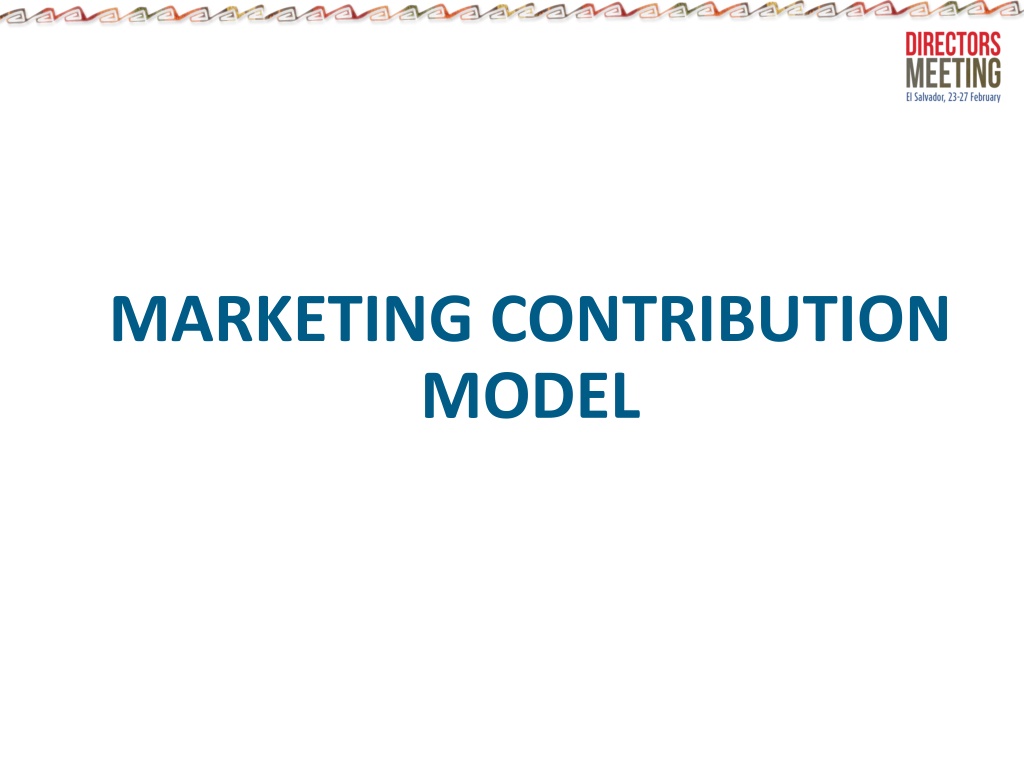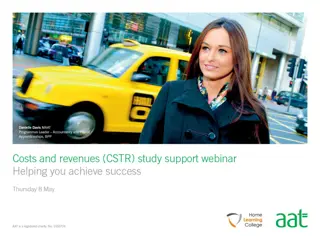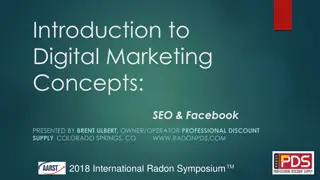Marketing Contribution Model Overview
This model discusses the evolution of marketing contribution strategies in English schools, emphasizing direct benefits to individual offices and negotiation tactics for higher commission rates. It also presents a list of agreements with various institutions, detailing contributions and validity periods. The data on marketing contributions received in 2013 from different English schools is included, showcasing the financial support provided to offices.
Download Presentation

Please find below an Image/Link to download the presentation.
The content on the website is provided AS IS for your information and personal use only. It may not be sold, licensed, or shared on other websites without obtaining consent from the author.If you encounter any issues during the download, it is possible that the publisher has removed the file from their server.
You are allowed to download the files provided on this website for personal or commercial use, subject to the condition that they are used lawfully. All files are the property of their respective owners.
The content on the website is provided AS IS for your information and personal use only. It may not be sold, licensed, or shared on other websites without obtaining consent from the author.
E N D
Presentation Transcript
MARKETING CONTRIBUTION MODEL
MARKETING CONTRIBUTIONS FROM INSITUTIONS Model created to obtain marketing support for offices from English schools Model was originally managed by Head Office and divided amongst small medium large offices Model changed to be directly for each office (ie each office benefits directly based on numbers sent) Good for the English schools as they do not pay unless the weeks of English are sent LAE also tries to negotiate higher commission rates and other benefits when negotiating the marketing contributions
MARKETING CONTRIBUTIONS LIST OF AGREEMENTS Validity Provider name Contribution Target From To Australia English Language Company Langports IH Sydney Browns Language Links SCE UNSW SACE Discover English ELS Imagine Education Shafston Greenwich College AIPE APC + EU Lexis AUD 1200 1200 1200 1500 1000 1000 1200 1000 1000 880 1200 1200 1000 1000 1200 1200 80 weeks 100 weeks 100 weeks 100 weeks 80 weeks 80 weeks 100 weeks 100 weeks 100 weeks 100 weeks 100 weeks 100 weeks 100 weeks 100 weeks 125 weeks 80 weeks Aug 1 2011 Indefinite Indefinite Indefinite Jan 16 2015 Indefinite Indefinite Dec 31 2014 Indefinite Indefinite Indefinite Indefinite Indefinite Indefinite Feb 28 2014 Indefinite Indefinite Sep 15 2011 Jan 16 2014 Oct 1 2011 Sep 15 2011 Jan 1 2013 Oct 12 2011 Oct 17 2011 Oct 20 2011 Feb 04/2013 Jan 1 2014 Mar 8 2012 Mar 1 2013 April 1 2012 April 1 2013 New Zealand Worldwide Schools Languages NZ NZD 750 750 50 weeks 50 weeks Jan 1 2014 Jan 1 2014 Dec 31 2014 Dec 31 2014 Multiple Destinations USD 80 weeks (all destinations, week combinations allowed) ILSC 1000 Nov 15 2013 Nov 15 2014
MARKETING CONTRIBUTIONS RECEIVED 2013 Marketing Contribution ($) Office English Weeks English Schools Bogota - El Chico 4,289 8,583 Ability, AIPE, Discover, Shafston Melbourne 3,601 3,564 Ability, Discover Medellin 1,750 3,180 Langports Adelaide 1,079 2,230 SACE Quito 486 2,016 International House Brisbane 1,359 1,604 Shafston Caracas 2,160 1,600 Imagine Guadalajara 267 1,382 APC Cali 1,905 1,350 Discover Santiago 3,920 1,260 Shafston Lima 1,220 1,200 Shafston Bucaramanga 1,188 1,080 Discover Barranquilla 514 1,075 AIPE
MARKETING CONTRIBUTIONS OFFICES WITH SUFFICIENT WEEKS Office English Weeks Sydney 1,746 Valencia 1,721 Barcelona 612 Mexico City - Polanco 569 Sao Paulo 452 Porto Alegre 411 Monterrey 380 Florianopolis 367 Maracaibo 336 Rio de Janeiro 335 Bogota - Salitre 317 Toluca 283 Arequipa 274
MARKETING CONTRIBUTIONS PLANNING MODULE Office Director can check number of weeks achieved Automatic email sent to office Director when the target weeks for the marketing contribution are achieved Automatic email sent to Marta with the required details to create an invoice for the marketing contribution
MARKETING BUDGETS LAE was able to grow using the marketing budgets of the institutions (and often did not have the liquidity to dedicate income to marketing when the office was starting up). Not having an obligatory marketing budget as a proportion of income is a key weakness in the LAE model LAE has the tools and the strategies but we do not have the marketing budgets We need dedicated marketing budgets if we are going to grow to our potential Competitors that invest heavily in marketing Global: EF Brazil: STB, CI Mexico: Mundo Joven Colombia: Global Connection, Grasshopper
MARKETING BUDGET WHAT ARE SOME OFFICES DOING? Cali 10% of profit dedicated to marketing Brazil 5% of profit (Brazilian wide marketing) + Development Fund Marketing Manager Italy, Barcelona 5% of profit dedicated to marketing in 2014 10% of profit dedicated to marketing in 2015 and thereafter Quito Part time Marketing Manager
HOW MUCH SHOULD BE SPENT ON MARKETING? Bloomberg Businessweek Small Business http://www.businessweek.com/smallbiz/content/feb2009/sb20090210_16 5498.htm Volume-driven companies tend to spend a tiny percentage of sales on marketing, in part because their large revenues enable small contributions to add up fast, and in part because of the margin pressures they face in having to compete with other high volume companies. By contrast, margin-driven companies tend to spend a larger percentage of sales on marketing: They have room in their margins to afford it, and they're often working from a smaller revenue base. For example, like most professional services firms, my company is more margin-oriented than volume-oriented, so fueling its growth requires that we spend a higher percentage of our revenues. Last year, our number was just over 8%, and I've seen companies spend upwards of 15% when warranted especially young companies that need to invest to build their brand.
HOW MUCH SHOULD BE SPENT ON MARKETING? Marketing as a Percentage of Revenue Benchmarks http://www.roguemarketer.typepad.com/the_rogue_marketer/marketing- as-a-percentage.html When setting marketing as a percentage of revenue benchmarks, the firm Go-to-Market Strategies has published a study on normative levels. According to their research "30% of companies spend between 3-5% of revenue on marketing, with 45% spending over 6% (most of those between 6-10%). If you are launching a new product, or are expecting to launch into a new market or territory, expect to spend approximately 20% of revenue to fund that program." The percentage of revenue approach, 8-10% of revenue should be spent on marketing, with approximately 5% of that going to labor (either for a department, or outsourcing to a marketing firm).
MARKETING BUDGET Have a fixed proportion of income for a marketing budget Small offices (< 30 students) 0% (15 offices) Medium Offices (30 70 students) 5% (6 offices) Large Offices (> 71 students) 10% (19 offices)























